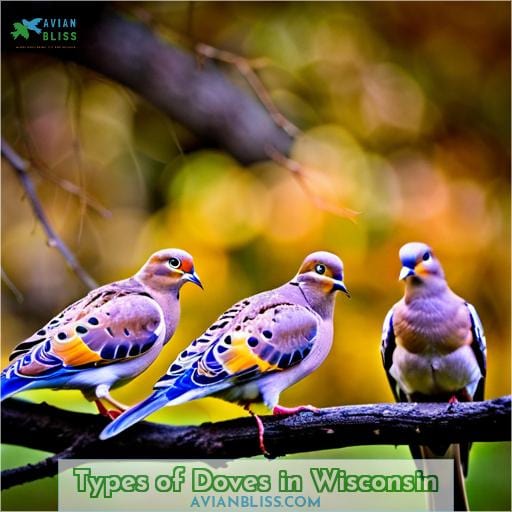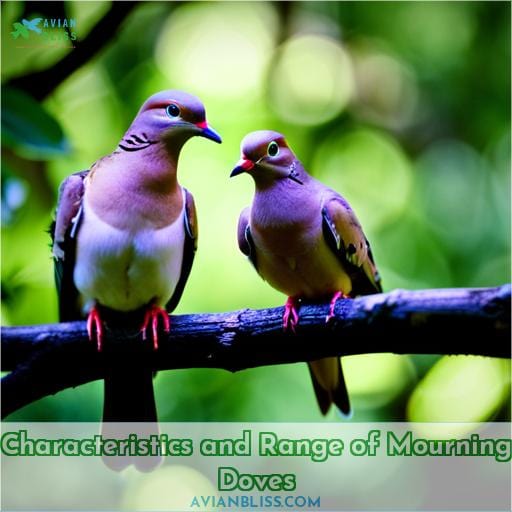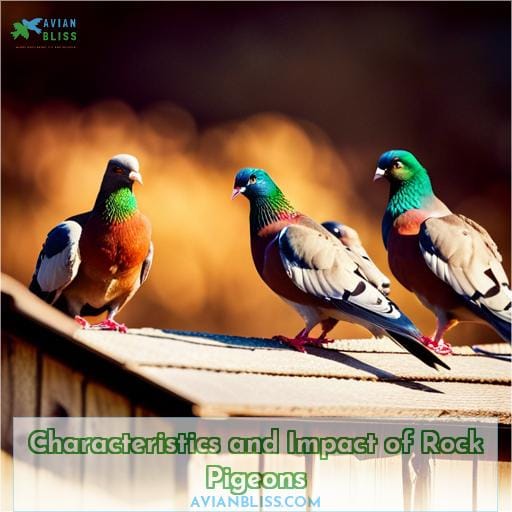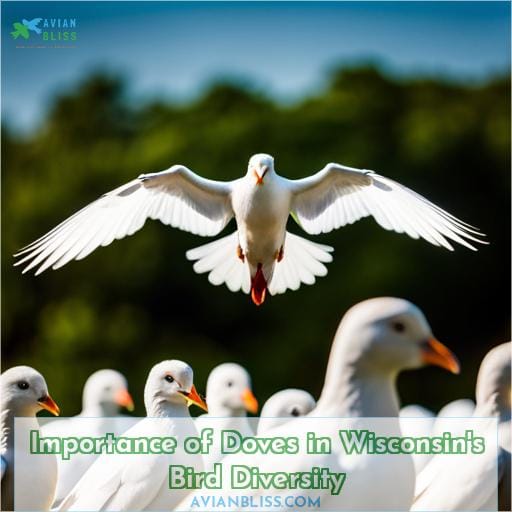This site is supported by our readers. We may earn a commission, at no cost to you, if you purchase through links.
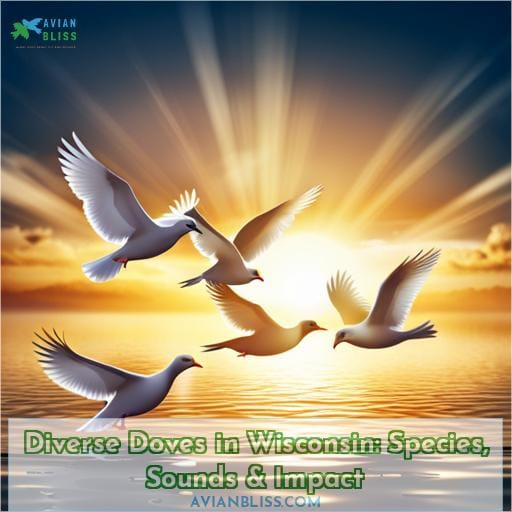
From the familiar Mourning Dove, distinguished by its pinkish-gray plumage adorned with black spots, to the unobtrusive Eurasian Collared-Dove, an occasional visitor to the Badger State, these avian residents paint a captivating portrait of adaptation and coexistence.
Delving into the distinctive traits of each dove species, this narrative sheds light on their habitats, behaviors, and significance. While the gentle Mourning Dove thrives year-round, its melodic cooing fills the air as a common presence at bird feeders.
Conversely, the Rock Pigeon, with its urban affinity and cultural ties, challenges conventional perceptions as both companion and concern. The Eurasian Collared-Dove, a rarity among Wisconsin’s avifauna, offers insights into the complexities of invasive species dynamics.
By unraveling the ecological roles, cultural connections, and conservation considerations surrounding these doves, this article beckons readers to explore, understand, and embrace the nuanced avian community that graces Wisconsin’s skies.
Table Of Contents
- Key Takeaways
- Types of Doves in Wisconsin
- Characteristics and Range of Mourning Doves
- Characteristics and Impact of Rock Pigeons
- Characteristics and Invasive Nature of Eurasian Collared-Doves
- Importance of Doves in Wisconsin’s Bird Diversity
- Frequently Asked Questions (FAQs)
- Sure, here are 5 frequently asked questions that would not normally be answered in the article:
- How do dove species communicate with each other, and are their calls distinct from other bird species in Wisconsin?
- What are some unique nesting behaviors or preferences exhibited by mourning doves that set them apart from other dove species in the region?
- Can the introduction of Eurasian Collared-Doves impact the native bird populations in Wisconsin, and if so, what are the potential ecological consequences?
- Are there any traditional or cultural ceremonies in Wisconsin that involve doves, and if yes, what roles do the different dove species play in these ceremonies?
- Are there any ongoing conservation efforts specifically focused on protecting and maintaining the habitat of these dove species within Wisconsin’s diverse ecosystems?
- Conclusion
Key Takeaways
- Mourning doves are common in Wisconsin and have a pinkish-gray plumage with black spots.
- Eurasian collared-doves thrive near bird feeders and adapt well to urban areas.
- Rock pigeons, although disruptive to the environment and competing with native species, have cultural significance as companions to humans.
- White-winged doves have grayish-brown plumage with white wing markings and migrate northward in the summer.
Types of Doves in Wisconsin
Introducing the diverse array of dove species in Wisconsin, you’ll delve into the world of the Mourning Dove, Eurasian Collared-Dove, Rock Pigeon, and the elusive White-winged Dove, discovering their unique characteristics. Each species presents unique characteristics and ecological roles, offering a fascinating lens through which to explore Wisconsin’s avian tapestry.
Mourning Dove
As you wander through the woodlands and parks, a soft gray presence catches your eye – the Mourning Dove, with its gentle cooing, seems to carry the weight of the world on its wings.
- Mourning Dove Behavior: Prolific breeding, multiple broods per season.
- Mourning Dove Songs: Mournful cooing that resonates in tranquil settings.
- Mourning Dove Nesting: Simple nests constructed with twigs, often found in trees and shrubs.
- Mourning Dove Symbolism: Cultural associations with peace and hope.
- Mourning Dove Feeding: Ground foragers, they feed on seeds, often frequenting bird feeders.
Eurasian Collared-Dove
Roaming the urban landscapes and cozy neighborhoods, you’ll spot the Eurasian Collared-Dove, its sandy-gray feathers and distinctive black collar adding a touch of wild charm to your surroundings. This invasive species, with its recognizable koo-KOO-kook song, thrives in human environments, often near bird feeders.
Rock Pigeon
Explore the urban landscapes of the region, where the Rock Pigeon, boasting distinctive gray variations and an iridescent head and neck, has established itself as a recognizable dweller. Often underestimated, this species bears intriguing history and fascinating adaptability.
Rock Pigeon Insights:
- Urban Mastery: Flourishing in cities, the Rock Pigeon showcases adaptability.
- Distinctive Appearance: Gray with iridescent hues, the pigeon’s head and neck are its hallmark.
- Human Interaction: Long associated with humans, it thrives in urban environments.
- Cultural Symbolism: Its presence holds cultural significance across civilizations.
- Conservation Concerns: Balancing its population is vital for urban ecosystems’ health.
White-winged Dove (Rare)
Delving into the realm of rare avian residents, the focus now turns to the White-winged Dove, an intriguing species with distinct grayish-brown plumage and striking white wing markings. This elusive dove is spotted primarily in Mexico and the Southern U.S. It migrates slightly northward during summer.
Conservation efforts target its fragile habitat due to its conservation status of Least Concern.
Below is a table shedding light on the White-winged Dove’s key traits and behaviors.
| Trait | Description |
|---|---|
| Nesting Habits | Utilizes trees and shrubs for nesting. |
| Migration | Migrates northward during summer. |
| Vocalizations | Cooing and soft hooting sounds. |
| Conservation | Listed as Least Concern due to stable populations. |
| Feeding | Feeds on seeds, fruit, and agricultural crops. |
Discovering the White-winged Dove offers a glimpse into the intricate interplay of migration, habitat, and behaviors, enriching the understanding of avian life in Wisconsin’s diverse landscape.
Characteristics and Range of Mourning Doves
Turning attention to the Mourning Dove, delve into its distinctive traits and distribution. The grayish-pink elegance of their undersides and their haunting, mournful cooing resonates across Wisconsin’s varied landscapes.
They gracefully adorn woodlands, backyards, and urban spaces, drawn to your offerings at bird feeders while their recognizable koo-KOO-kook song echoes in the air.
Mourning Dove Range Map
Navigate the terrain of knowledge to uncover the fascinating range of the Mourning Dove, tracing its gentle presence across woodlands, parks, and even your very own backyard.
- Mourning Dove Behavior: Recognizable by gray plumage, black wing spots, and mournful cooing. Prolific breeders with multiple broods per season.
- Eurasian Collared Dove Distribution: Concentrated in the West, sandy gray with a black collar, recognized by koo-KOO-kook song.
- Rock Pigeon Urban Adaptation: Gray variations, associated with urban environments.
- Dove Symbolism: Cultural significance as a symbol of peace, hope, and purity.
Common Presence in Wisconsin
Discover the ubiquitous presence of these gentle creatures as they gracefully inhabit woodlands, parks, backyards, and cities across the region.
From the mournful cooing of the Mourning Dove to the distinctive koo-KOO-kook song of the Eurasian Collared-Dove, their sounds resonate.
The table below encapsulates their diverse range distribution and habitat preferences.
| Species | Habitat | Range Distribution |
|---|---|---|
| Mourning Dove | Woodlands, parks, backyards | Throughout Wisconsin |
| Eurasian Collared-Dove | Urban areas, human habitation | Concentrated in the West |
| Rock Pigeon | Urban environments | Worldwide urban presence |
Through their breeding behavior and foraging preferences for bird seeds and agricultural crops, these doves enrich Wisconsin’s avian tapestry and offer a sense of belonging and freedom to the landscape.
Attracting Mourning Doves to Bird Feeders
Lure these gentle avian visitors with the allure of carefully placed feeders, and let their soothing presence grace your outdoor space. Mourning doves, common in Wisconsin, exhibit distinct feeding preferences—seeds, especially sunflower seeds, draw them in.
They favor ground feeding, displaying their characteristic gentle nature. During nesting, pairs create simple, loosely-built nests in trees or shrubs.
Recognizable Cooing Sound of Mourning Doves
Listen closely, and a soft, mournful melody will grace your ears – the unmistakable cooing song of the Mourning Dove, weaving a gentle thread of nature’s harmony into the tapestry of your surroundings.
This enchanting sound serves not only as a vocal signature but also offers insights into their nesting habits and social interactions. Mourning Doves, with their pinkish-gray bodies adorned with black spots, are often spotted perched on power lines, emitting their distinctive cooing that resonates with a sense of belonging and freedom.
This song’s cadence carries the essence of their existence, connecting you to the delicate yet resilient lives of these Wisconsin doves.
Characteristics and Impact of Rock Pigeons
Introducing the impact of Rock Pigeons in Wisconsin’s urban landscape, you’ll delve into their dual role as both cultural symbols and pests in many cities. Analyzing their association with humans and their ecological effect within urban environments, you’ll uncover the intricate dynamics of these birds in a scientific and objective manner.
Considered a Pest in Many Wisconsin Cities
In several urban centers across the state, the steady increase in Rock Pigeon populations has sparked concerns about their impact on local environments. This resembles an unchecked expansion that casts shadows over the city’s natural harmony.
Urban Challenges:
- Environmental Disruption: Pigeons’ nesting habits and droppings pose sanitation and aesthetic challenges.
- Competing Species: Their dominance competes with native birds for resources and nesting sites.
- Cultural Shift: Pigeons’ cultural symbolism contrasts with their pest species status, creating complex perceptions.
Pigeon behavior, exemplified by their prolific breeding and adaptability, further fuels the situation. Management strategies, including introducing peregrine falcons and altering urban landscapes, aim to restore equilibrium.
The juxtaposition of pigeons as cultural icons and urban pests underscores the intricate balance between nature and civilization.
Cultural Significance and Association With Humans
Experience the profound bond between these gentle creatures and our lives, as they’ve woven themselves into the very fabric of our shared history and culture. Rock pigeons, often mistaken for mere urban nuisances, possess cultural symbolism that spans across civilizations.
Their homing abilities have fascinated humans, leading to their domestication for communication and companionship. Observing breeding pairs during Wisconsin birdwatching ventures highlights their intricate role in local wildlife and underscores their enduring cultural significance.
Ecological Impact in Urban Environments
Amidst urban landscapes, these feathered architects fashion their nests from city debris, crafting homes with a touch of urban flair that even the most avant-garde designer would envy. Rock pigeons, common inhabitants of North American cities, exhibit remarkable urban adaptation.
Their grayish-brown plumage seamlessly blends with concrete surroundings, and they’ve formed a unique coexistence with humans. While they contribute to the urban ecosystem by consuming discarded food, managing their population to maintain ecological balance remains a challenge.
Characteristics and Invasive Nature of Eurasian Collared-Doves
Delving into the realm of dove species in Wisconsin, the focus now shifts to the Eurasian Collared-Dove—an intriguing presence marked by its rarity as an invasive species in the state. Examining its habitat preferences and behavior unveils a tale of adaptability, as this sandy-hued dove thrives around human habitation.
Its distinctive black collar and unmistakable koo-KOO-kook song form the core of its identification, standing as a testament to its unique characteristics in the avian tapestry of Wisconsin.
Rarity as an Invasive Species in Wisconsin
Discovering the unique and uncommon presence of Eurasian Collared-Doves in Wisconsin enriches the intricate tapestry of local avian diversity. Unlike their rock pigeon counterparts, these sandy brown doves bear a distinctive black collar on their necks.
Their recognizable koo-KOO-kook song echoes around human habitation, illustrating their adaptability. While some view their invasive nature negatively, these doves, alongside other species like the White-winged Dove, showcase the ever-evolving dynamics of ecological interactions.
Habitat Preferences and Behavior
Engage with the captivating lives of these remarkable avian inhabitants as they intricately shape their surroundings through distinct preferences and behaviors, leaving an indelible mark on the vibrant tapestry of their shared ecosystem.
Nesting Habits: Eurasian Collared-Doves favor urban locales for nesting, often choosing ledges, eaves, and even man-made structures. Their adaptability to urban environments is a testament to their resourcefulness.
Vocalizations During Mating: During the breeding season, their koo-KOO-kook call intensifies, serving as a melodious announcement of their intentions to potential mates.
Foraging Behavior in Cities: These doves primarily forage on the ground for seeds and grains, making them a common sight in city parks and gardens, where they scavenge for sustenance.
Their breeding season variations, interactions with other bird species, and foraging habits in urban settings continue to intrigue ecologists and bird enthusiasts alike.
Distinctive Features and Identification
Explore the unique traits and distinct features that set these feathered inhabitants apart, captivating your attention with their graceful nuances and unmistakable characteristics. The mournful cooing of Mourning Doves, a soothing serenade in woodlands and urban landscapes, contrasts with the recognizable koo-KOO-kook song of the Eurasian Collared-Dove, a species that rapidly spreads across the West.
The Rock Pigeon, with its plump form and urban demeanor, stands as a symbol of urbanization, while the White-winged Dove’s migratory journey embodies freedom and adaptation.
Importance of Doves in Wisconsin’s Bird Diversity
Moving beyond their cultural symbolism, the doves inhabiting Wisconsin play a pivotal ecological role. Their distinct habitat preferences and behaviors contribute significantly to the rich tapestry of bird diversity that defines Wisconsin’s ecosystems.
Ecological Role and Habitat Preferences
Immerse yourself in the intricate tapestry of nature’s interconnectedness as you witness the harmonious dance between these gentle creatures and the diverse landscapes they call home. Doves in Wisconsin, with their adaptable nature, play crucial roles in the ecosystem.
Nesting patterns reveal their capacity to thrive across urban and natural environments, displaying remarkable urban adaptation. Feeding habits, ranging from seed foraging to urban scraps, underscore their ability to coexist with humans.
Breeding seasons coincide with ample food availability, contributing to their successful proliferation. Human interaction, often centered around bird feeders, further underscores their significance, fostering a sense of shared belonging and understanding within the community.
Contribution to Wisconsin’s Rich Bird Diversity
Discover how these graceful creatures contribute significantly to the vibrant tapestry of bird species enriching Wisconsin’s biodiversity. Doves’ avian adaptations enable them to thrive in varied habitats, from woodlands to urban landscapes.
Their presence, rooted in cultural symbolism, exemplifies the intertwined relationship between humans and nature. Mourning doves’ prolific breeding patterns enhance their representation, while Eurasian collared-doves’ successful invasion reflects adaptability.
Amid urban ecology, rock pigeons’ association with humanity brings both positive and negative ecological impacts. This intricate interplay of avian life showcases the harmony and challenges of coexistence, offering a profound lens into Wisconsin’s diverse bird community.
Frequently Asked Questions (FAQs)
Sure, here are 5 frequently asked questions that would not normally be answered in the article:
Discover the allure of Wisconsin’s doves. Unveil their distinctive traits, habitats, and cultural resonance. Dive into their ecological role, bridging nature and humanity. Satisfy your curiosity about these enchanting avian cohabitants.
How do dove species communicate with each other, and are their calls distinct from other bird species in Wisconsin?
Dove species communicate through distinct calls. The mournful coo of the Mourning Dove, the recognizable koo-KOO-kook of the Eurasian Collared-Dove, and the urban-dwelling Rock Pigeon’s coos create a symphony connecting Wisconsin’s avian inhabitants.
What are some unique nesting behaviors or preferences exhibited by mourning doves that set them apart from other dove species in the region?
Mourning doves exhibit unique nesting behaviors in Wisconsin. They construct flimsy stick nests in trees, often reusing old nests. Their preference for horizontal branches and open areas distinguishes them, fostering a sense of connection with Wisconsin’s diverse habitats.
Can the introduction of Eurasian Collared-Doves impact the native bird populations in Wisconsin, and if so, what are the potential ecological consequences?
The introduction of Eurasian Collared-Doves could impact Wisconsin’s native bird populations. Competition for resources and nesting sites might disrupt ecosystems, influencing local species’ survival and altering their ecological roles.
Are there any traditional or cultural ceremonies in Wisconsin that involve doves, and if yes, what roles do the different dove species play in these ceremonies?
Traditional ceremonies in Wisconsin involve doves, reflecting cultural ties to peace and unity. While exact roles vary, Mourning Doves often symbolize hope and remembrance, complementing the Eurasian Collared-Dove’s representation of adaptability and coexistence.
Are there any ongoing conservation efforts specifically focused on protecting and maintaining the habitat of these dove species within Wisconsin’s diverse ecosystems?
Amid Wisconsin’s diverse landscapes, a symphony of conservation efforts resonates. Initiatives like habitat restoration and public awareness campaigns are the conduits of hope, preserving dove species’ melodies in the tapestry of local ecosystems.
Conclusion
Amidst Wisconsin’s diverse avian inhabitants, did you know that four distinct dove species quietly grace the state? Mourning Doves, with their gray plumage and soothing coos, grace woodlands and yards alike.
The Rock Pigeon, though often deemed a pest, boasts a remarkable cultural connection and ecological impact in urban settings. Notably, the Eurasian Collared-Dove, a rarity as an invasive species, stands out with its sandy hue and recognizable koo-KOO-kook call.
These doves contribute significantly to Wisconsin’s rich bird diversity, emphasizing their importance in the state’s ecological tapestry.
So, explore the fascinating world of Doves in Wisconsin, where their species, sounds, and impact converge in harmony.

